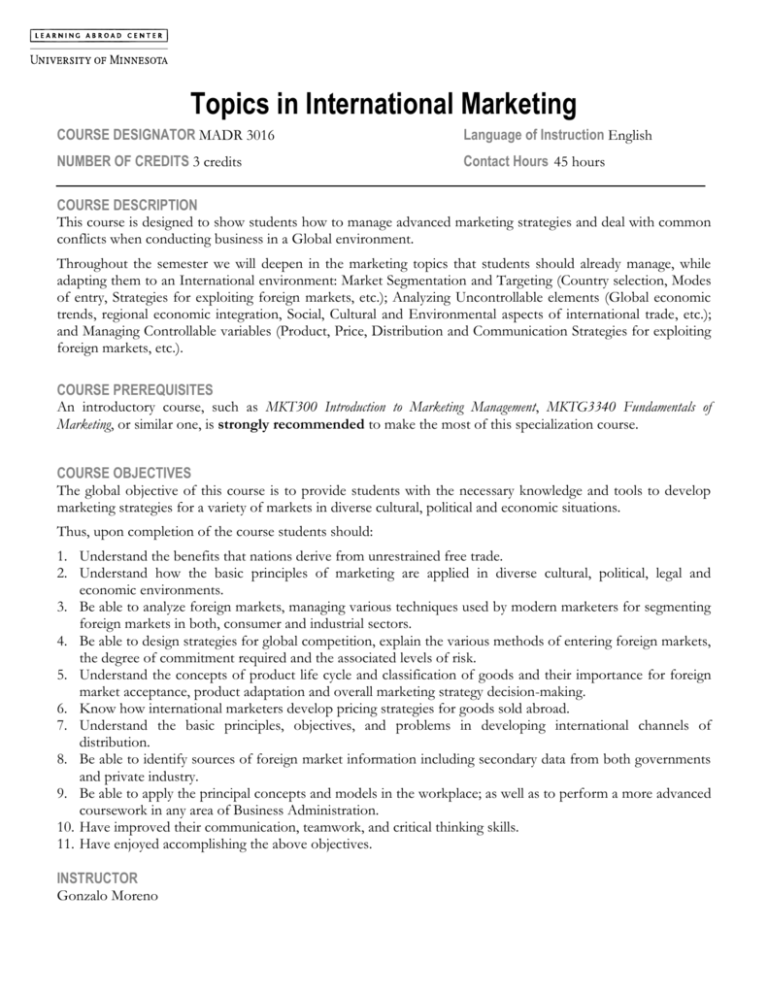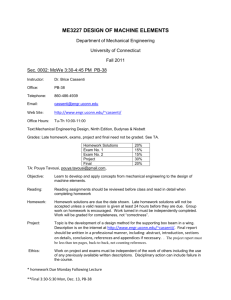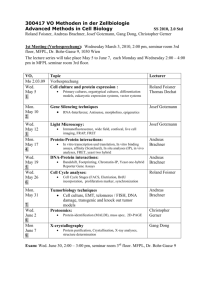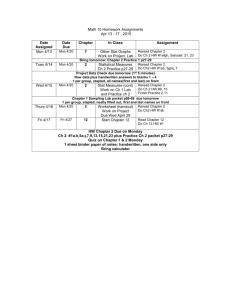Link to Syllabus - Learning Abroad Center
advertisement

Topics in International Marketing COURSE DESIGNATOR MADR 3016 Language of Instruction English NUMBER OF CREDITS 3 credits Contact Hours 45 hours COURSE DESCRIPTION This course is designed to show students how to manage advanced marketing strategies and deal with common conflicts when conducting business in a Global environment. Throughout the semester we will deepen in the marketing topics that students should already manage, while adapting them to an International environment: Market Segmentation and Targeting (Country selection, Modes of entry, Strategies for exploiting foreign markets, etc.); Analyzing Uncontrollable elements (Global economic trends, regional economic integration, Social, Cultural and Environmental aspects of international trade, etc.); and Managing Controllable variables (Product, Price, Distribution and Communication Strategies for exploiting foreign markets, etc.). COURSE PREREQUISITES An introductory course, such as MKT300 Introduction to Marketing Management, MKTG3340 Fundamentals of Marketing, or similar one, is strongly recommended to make the most of this specialization course. COURSE OBJECTIVES The global objective of this course is to provide students with the necessary knowledge and tools to develop marketing strategies for a variety of markets in diverse cultural, political and economic situations. Thus, upon completion of the course students should: 1. Understand the benefits that nations derive from unrestrained free trade. 2. Understand how the basic principles of marketing are applied in diverse cultural, political, legal and economic environments. 3. Be able to analyze foreign markets, managing various techniques used by modern marketers for segmenting foreign markets in both, consumer and industrial sectors. 4. Be able to design strategies for global competition, explain the various methods of entering foreign markets, the degree of commitment required and the associated levels of risk. 5. Understand the concepts of product life cycle and classification of goods and their importance for foreign market acceptance, product adaptation and overall marketing strategy decision-making. 6. Know how international marketers develop pricing strategies for goods sold abroad. 7. Understand the basic principles, objectives, and problems in developing international channels of distribution. 8. Be able to identify sources of foreign market information including secondary data from both governments and private industry. 9. Be able to apply the principal concepts and models in the workplace; as well as to perform a more advanced coursework in any area of Business Administration. 10. Have improved their communication, teamwork, and critical thinking skills. 11. Have enjoyed accomplishing the above objectives. INSTRUCTOR Gonzalo Moreno METHODOLOGY Classes will be a mix of lecture (theory) and real-life case studies discussion (practice). Students are required to prepare each lesson ahead (according to course schedule of classes) so as to make classes participative and dynamic. Tests (15% + 20%): There will be two midterm tests. Each test will cover half of the course content. Most of the material on the tests will be taken from the textbook. Nevertheless, anything discussed in class is potential test material. At the same time, the course project will ensure a practical application of the course contents, expressed in two presentations. Group Presentations (25% + 30%): Students will be assigned to a group of 3 to 5 members. Each group will, firstly, analyze and present a Multinational Market Region, including its Multinational Free-Trade Areas and Agreements: North America (NAFTA), Latin America (CARICOM, CAFTA, Mercosur), Asia-Pacific (ASEAN), EMEA (EU, Arab Common Market, OIC, Afican Union, ECOWAS, SADC). Secondly, upon termination of the previous analysis, by the end of the course, groups will propose a Marketing Strategy for the regional launch of one common product. This project will be graded on the basis on creativity, thoroughness of the analysis and practical application of course contents. REQUIRED READING/MATERIALS 1) Cateora, Gilly, Graham, International Marketing 14th. International Ed. 2009, McGraw Hill * Newer versions of the text (16th Ed) are available only in the American Ed. Book to buy/use is at students’ discretion. 2) Selected Case Studies and specific materials. GRADING Attendance Class Participation Tests Project presentations 0% (considered in Students’ best interest) 10% 35% = 15% + 20% 55% = 20% + 30% CRITERIA FOR GRADING AND GRADING STANDARDS Grading Rubric A 93-100 AB+ B BC+ C CD+ D F 90-92 87-89 83-86 80-82 77-79 73-76 70-72 67-69 60-66 0-59 Achievement that is outstanding relative to the level necessary to meet course requirements. Achievement that is significantly above the level necessary to meet course requirements. Achievement that meets the course requirements in every respect. Achievement that is worthy of credit even though it fails to meet fully the course requirements. Represents failure (or no credit) and signifies that the work was either (1) completed but at a level of achievement that is not worthy of credit or (2) was not completed and there was no agreement between the instructor and the student that the student would be awarded an I. Summary of how grades are weighted: PAGE 2 Attendance 5% Class Participation 10% Homework and assignments 30% Mid-term project presentation 25% Final Project presentation 30% Overall Grade 100% TENTATIVE/SAMPLE CLASS SCHEDULE INTERNATIONAL MARKETING DAY Mon Wed Mon Wed Mon Wed Mon Wed Mon Wed Mon Wed Mon Wed Mon Wed Mon Wed Mon Wed Mon Wed Mon Wed Mon Wed Mon Wed 12/01/15 14/01/15 19/01/15 21/01/15 26/01/15 28/01/15 02/02/15 04/02/15 09/02/15 11/02/15 16/02/15 18/02/15 23/02/15 25/02/15 02/03/15 04/03/15 09/03/15 11/03/15 16/03/15 18/03/15 23/03/15 25/03/15 30/03/15 01/04/15 06/04/15 08/04/15 13/04/15 15/04/15 CLASS # 1 2 3 4 5 6 7 8 9 10 11 12 13 14 15 16 17 18 19 20 21 22 23 24 25 26 CONTENT Introduction to the course OVERVIEW: The scope of International Marketing OVERVIEW: International Trade CULTURE: Assesing Global Markets Conclusions: Main Variables assesing Global Markets CULTURE: Management style and Business Systems CULTURE: The political environment CULTURE: The international legal environment FIRST MIDTERM EXAM Developing a Global Vision: Marketing Research Emerging Markets Students' Presentations: Multinational Market Regions I Students' Presentations: Multinational Market Regions II Conclusions on Global Market Oppotunities Global MK Management: Planning and Organization Products and Services for Consumers Products and Services for Businesses International Marketing Channels Exporting and Logistics: Special issues for bussinesses IMC and International Advertising Guest speaker TBC Personal Selling and Sales Management Pricing for International Markets Conclusions on Global Marketing Strategies SECOND MIDTERM EXAM Students' Presentations: Multinat'l Marketing Strategy I Students' Presentations: Multinat'l Marketing Strategy II Course Conclusions READINGS (CHAPTER) -1 2 4 -5 6 7 8 9 (10) (10) -11 12 13 14 15 16 -17 18 ----- NOTES: This course is designed to be completed in between 20 and 26 lecture sessions. The course may also be completed with a +/-5hr. practicum, consisting in a set of organized visits to retail distribution sites (around sessions 17 / 18) PAGE 3 ATTENDANCE POLICY Regular attendance and punctuality are mandatory in order to earn full marks. The final grade will take into consideration preparation required for class (i.e. readings) and participation in class discussions. If you miss any meetings without an excused absence from the on-site director, your final grade will be dropped accordingly. In the case of absences, it is the student’s responsibility to find out what information was given in class including any announcements made. UNIVERSITY OF MINNESOTA POLICIES AND PROCEDURES Academic integrity is essential to a positive teaching and learning environment. All students enrolled in University courses are expected to complete coursework responsibilities with fairness and honesty. Failure to do so by seeking unfair advantage over others or misrepresenting someone else’s work as your own, can result in disciplinary action. The University Student Conduct Code defines scholastic dishonesty as follows: SCHOLASTIC DISHONESTY: Scholastic dishonesty means plagiarizing; cheating on assignments or examinations; engaging in unauthorized collaboration on academic work; taking, acquiring, or using test materials without faculty permission; submitting false or incomplete records of academic achievement; acting alone or in cooperation with another to falsify records or to obtain dishonestly grades, honors, awards, or professional endorsement; altering forging, or misusing a University academic record; or fabricating or falsifying data, research procedures, or data analysis. Within this course, a student responsible for scholastic dishonesty can be assigned a penalty up to and including an “F” or “N” for the course. If you have any questions regarding the expectations for a specific assignment or exam, ask. STUDENT CONDUCT The University of Minnesota has specific policies concerning student conduct and student needs. This information can be found on the Learning Abroad Center website. PAGE 4








